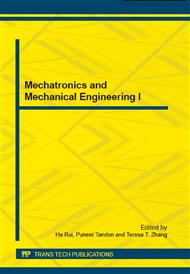[1]
M. Mazaheri, F. Djavanroodi, andK. M Nikbin: Creep life assessment of an overheated 9 Cr-1 Mo steel tube, International Journal of Pressure Vessels and Piping (2010), pp.746-752.
DOI: 10.1016/j.ijpvp.2010.08.013
Google Scholar
[2]
R. N. Gosh: Creep Life Predictions of Engineering Components: Problems and Prospects, Procedia Engineering(2013), pp.599-606.
DOI: 10.1016/j.proeng.2013.03.301
Google Scholar
[3]
S. Nandi, K.S.N. Vikrant, A.H.V. Pavan, K. Singh, andR.N. Gosh: Creep modeling of P91 Steel for High Temperature Power Plant Applications, Procedia Engineering(2013), pp.751-755.
DOI: 10.1016/j.proeng.2013.03.326
Google Scholar
[4]
F. Matsuyama: Advance in Creep Damage/Life Assessment Technology for Creep Strength Enhanced Ferritic Steel, Procedia Engineering(2013), pp.591-598.
DOI: 10.1016/j.proeng.2013.03.300
Google Scholar
[5]
C.C. Manu, A.M. Birk, and I.Y. Kim: Uniaxial high-temperature creep property predictions made by CDMand MPC omega techniques for ASME SA 455 steel, Engineering Failure Analysis Vol. 16 (2009), p.1303–1313.
DOI: 10.1016/j.engfailanal.2008.08.005
Google Scholar
[6]
G. Antaki, in: Fitness for Service and Integrity of Piping, Vessels and Tanks, McGraw-Hill Companies, Inc. USA (2005).
Google Scholar
[7]
T. L. Anderson andD. A. Osage: API 579: a comprehensive fitness-for-service guide, International Journal of Pressure Vessels and Piping vol. 77 (2000), pp.953-96.
DOI: 10.1016/s0308-0161(01)00018-7
Google Scholar
[8]
P. Tantichattanont, S.M.R. Adluri, and R. Seshadri: Fitness-for-service assessment of spherical pressure vessels with hot spots, International Journal of Pressure Vessels and Piping Vol. 84 (2007), p.762–772.
DOI: 10.1016/j.ijpvp.2006.12.003
Google Scholar
[9]
P. Tantichattanont, S.M.R. Adluri and R. Seshadri: Structural integrity evaluation for corrosion in spherical pressure vessels, International Journal of Pressure Vessels and Piping Vol. 84 (2007), p.749–761.
DOI: 10.1016/j.ijpvp.2006.12.004
Google Scholar
[10]
M.M. Hossain, and R. Seshadri: Simplified fitness-for-service assessment of pressure vessels and piping systems containing thermal hot spots and corrosion damage, International Journal of Pressure Vessels and Piping Vol. 87 (2010), pp.381-388.
DOI: 10.1016/j.ijpvp.2010.04.001
Google Scholar
[11]
J.M. Alegre, P.M. Bravo, I.I. Cuesta: Fatigue design of wire-wound pressure vessels using ASME-API 579 procedure, Engineering Failure Analysis(2010), pp.748-759.
DOI: 10.1016/j.engfailanal.2009.08.008
Google Scholar
[12]
B. Dogan: Fitness for service of welded components under creep and creep fatigue loading, International Journal of Pressure Vessels and Piping Vol. 87 (2010), pp.656-663.
DOI: 10.1016/j.ijpvp.2010.08.001
Google Scholar
[13]
L. Shuanlu, H. Yong,Q. Changyi, Y. Pengbin, Z. Xinwei, andL. Jinheng: Crack and fitness-for-service assessment of ERW crude oil pipeline, Engineering Failure Analysis(2006), pp.565-571.
DOI: 10.1016/j.engfailanal.2005.01.007
Google Scholar
[14]
American Petroleum Institute (API) in: API 579: Fitness-for-service, Washington DC (2000).
Google Scholar


